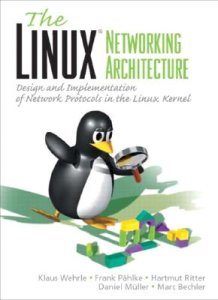
|
FreeComputerBooks.com
Links to Free Computer, Mathematics, Technical Books all over the World
|
|
- Title: The Linux Networking Architecture: Design and Implementation of Network Protocols in the Linux Kernel
- Author(s) Klaus Wehrle, Frank Pahlke, Hartmut Ritter, Daniel Muller, Marc Bechler
- Publisher: Prentice Hall (May 9, 2004)
- Hardcover/Paperback: 648 pages
- eBook: PDF
- Language: English
- ISBN-10: 0131777203
- ISBN-13: 978-0131777200
- Share This:

|
Written to give students and professionals the basics required to implement network functionality in the Linux kernel, this book also addresses everyone who wants to deepen their understanding of network specific processes in an operating system. This book introduces the key components and mechanisms of the Linux kernel and the designs of communication systems.
This unique Linux networking tutorial/reference by experts provides readers with a practical overview and understanding of the implementation of networking protocols in the Linux kernel. The book shows how networking behavior and protocols can be implemented within the Linux operating system. The book provides an introduction to the Linux kernel, mainly focusing on the upcoming kernel version 2.4 but also valid for version 2.2 kernels.
The organization of the book follows the TCP/IP layering model, beginning with the kernel's network device drivers, continuing with link-layer protocols such as PPP, and finally giving a description of all core protocols of the TCP/IP protocol family. Additional supplementary protocols such as RSVP, IP Security, and Mobile IP are also covered.
About the Authors- N/A
- Unix/Linux Networking
- Unix/Linux System Administration
- Networks Security, Administration and Management

- The Linux Networking Architecture: Design and Implementation of Network Protocols
- The Mirror Site (1) - PDF
-
 Linux Networking (Paul Cobbaut)
Linux Networking (Paul Cobbaut)
This book covers everything you need to know to perform your job as a Linux network administrator, whether you're new to the job or have years of experience. You'll dive straight into the gnarly hands-on work of building and maintaining a computer network.
-
 O'Reilly® Linux Network Administrator's Guide, 2nd Edition
O'Reilly® Linux Network Administrator's Guide, 2nd Edition
This book spells out all the information needed for joining a network, whether it's a simple UUCP connection or a full LAN with a Linux system serving as a firewall, an NFS or NIS file server, and a mail and news hub.
-
 Beej's Guide to Unix Network Programming (Brian Hall)
Beej's Guide to Unix Network Programming (Brian Hall)
The Guide is designed to irreverently ease your first steps into Internet Sockets programming in C. Starting from the ground up, it provides complete examples of simple clients and servers supporting both IPv6 and IPv4.
-
 TCP/IP Illustrated, Vol. 1: The Protocols (W. Richard Stevens)
TCP/IP Illustrated, Vol. 1: The Protocols (W. Richard Stevens)
This an excellent text that provides encyclopedic coverage of the TCP/IP protocol suite. What sets this book apart from others on this subject is the fact that the author supplements all of the discussion with data collected via diagnostic programs.
-
 Linux IP Networking (Glenn Herrin)
Linux IP Networking (Glenn Herrin)
This book is a guide to understanding how the Linux kernel implements networking protocols, focused primarily on the Internet Protocol (IP). It is intended as a complete reference for experimenters with overviews, walk-throughs, and examples.
-
 Linux Packet Filtering and iptables (Oskar Andreasson)
Linux Packet Filtering and iptables (Oskar Andreasson)
This document describes how to use iptables to filter out bad packets for the Linux kernels. It is assumed you know what an IP address, a network address, a netmask, routing and DNS are.
-
 Programming UNIX Sockets in C - Frequently Asked Questions
Programming UNIX Sockets in C - Frequently Asked Questions
This is a list of frequently asked questions, with answers about programming TCP/IP applications in UNIC with the sockets interface - you'll have experience of working with client-server applications, and be able to implement new network programs in C.
-
 UNIX Network Programming with TCP/IP (Alan Dix)
UNIX Network Programming with TCP/IP (Alan Dix)
This book describes describes the fundamental concepts of client-server computing used to build all distributed computing systems, and presents an in-depth guide to the Posix sockets standard utilized by UNIX and other operating systems.





